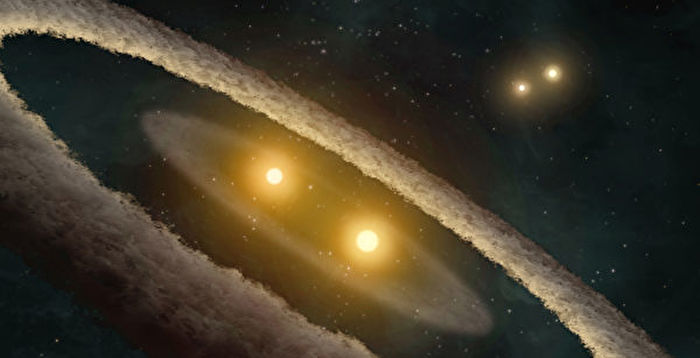[Epoch Times, February 26, 2022](The Epoch Times reporter Di Rui compiled and reported) The Transiting Exoplanet Survey Satellite (TESS) is a space telescope launched by NASA, mainly used to find and observe exoplanets . But recently, scientists have discovered 97 celestial systems consisting of four stars from its massive observational data.
As the name suggests, the TESS telescope explores exoplanets through changes in starlight caused by planets passing in front of them. Since its launch, it has scanned nearly 85% of the sky, providing scientists with a wealth of astronomical data.
These data are complex and disordered, and scientists must analyze them through various methods to be able to interpret all kinds of information that people want to know, including the mass, density, volume and orbit of exoplanets. Now, by using machine learning algorithms, an international team of researchers has discovered information about four-body stars.
NASA’s Goddard Space Flight Center and the MIT Kavli Institute for Astrophysics and Space collaborated on the analysis with the help of seven scientists.
“In order to rule out false positives caused by nearby stars or other overall factors, we have to analyze the light curvature of the observed target pixel by pixel,” the researchers wrote in their analysis report.
Why is it so difficult? The Universe Today report explained that because the so-called four-star system is composed of two binary star systems that orbit each other and are close enough to each other. However, even if the observational data shows that the two binary star systems are orbiting each other, if the two binary star systems are far apart, the interaction effect between them may not be reflected in hundreds of years. This is not the four-star system that scientists now plan to probe.
In the images shown by TESS observations, one pixel represents an extremely wide range of space in the universe. For example, two binary star systems at a distance of 500 parsecs (the cosmic scale unit, 1 parsec is about 3.26 light-years) from the earth, the distance between them is two pixels, which means that they are separated by about 20,000. An astronomical unit (AU, also a unit of distance described in astronomy, an astronomical unit is equivalent to the distance between the earth and the sun). Two systems so far apart, in the time scale of Earthlings, the effect of their interaction can only be reflected in the time span of several generations. So the researchers needed to filter these systems out of the results, what they refer to as “pixel-by-pixel analysis.”
Therefore, this study left 97 four-star systems, all composed of two binary star systems that are close enough to each other, and the impact between them will be reflected in a period of months or years.
These four-star systems have important implications for understanding the birth and evolution of stars, the study said. For example, the characteristics of the mass grouping in the stars, the ratio of the orbiting period, the orbital inclination, etc., it can be seen that these stars are born from a large dust disk split into small clumps, or whether the dust gathers into clusters under the action of gravity and was born.
Of course, if there are planets in these four-star systems, they are also objects of great interest to scientists. Several planets in four-star systems have been discovered before. Scientists know very little about its birth process and future evolutionary fate.
For example, in 2019, a peculiar four-star system, HD 98800, was discovered, with the star plane at right angles to the protoplanetary disk. Imagine what a few suns in the sky would look like from a planet born in this protoplanetary disk? ◇
Responsible editor: Ye Ziwei
